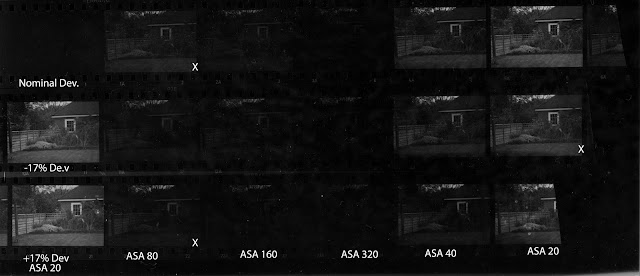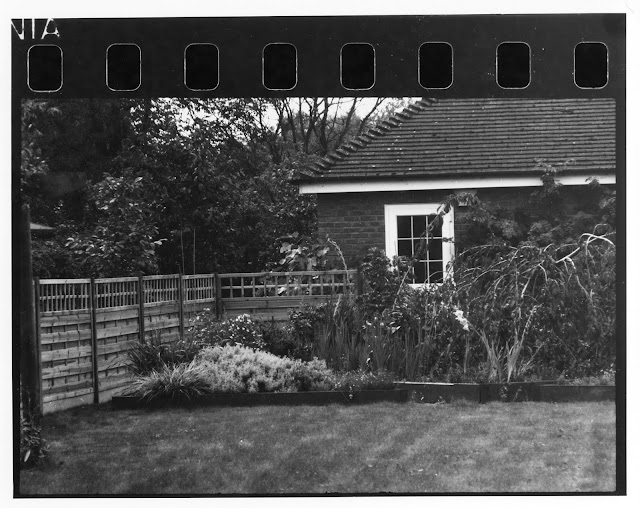Ferrania P30 Alpha Test
I joined the original Kickstarter Campaign for Ferrania. The journey has been long waiting for the rewards. I joined as a means to support any effort for film photography. Thus I am happy to be asked to buy their interim product; a black and white 35mm film based on the formula for Ferrania's historical P30 movie film. This was meant to to be a pipe cleaning exercise for the resurrected factory. I am not a big fan of 35mm and prefer medium format. The original rewards were to be color reversal film in different formats including medium format.
About a month ago I finally got my film and today got around to processing it. I decided to follow the process outlined in my previous post here. I made a roll of test exposures on my Olympus OM1 metered separately with a digital light meter (Sekonic) at ASA 80 box speed. I exposed +/-1 and +/- 2 stops and nominal tests. I developed in D76 stock at 7:00 minutes 20 degrees (compensated for 24 degree developer temperature) according to the best practices v1.5 from Ferrania for nominal development and +/-17% as well. I made a contact print at 00 filtration.
The development times were as follows: D76 7:00 Min 20C
Nominal 6:00 24C
-17% 5:00 24C
+17% 7:00 24C
Below is the contact print done at #00 filtration. I exposed the print at the time that just achieved total black in the blank film areas. The top strip is nominal development, the second at -17% dev time, and the bottom at +17% dev time. Ignoring the first column there are different exposures corresponding to ASA 80, ASA160, ASA 320, ASA40, and ASA 20. For the last two rows the ASA20 appears again in the first column. The X's in the lower right corner of images indicate which images subsequent prints were made from.
The results indicate the best results are at 1 or 2 stops over exposed. At box speed the negatives are noticeably thin, even with 17% extra developing time. My results do not make me believe the film is as fast as Ferrania indicates.
Here is a look at the negatives themselves in the same order to see the thinness present in the ASA80 exposures.
I made a series of split contrast prints to see if I could perceive differences. The first was from I judged best from the contact print. That is ASA 20 with development -17% shorter dev. time.This cam out on the first try by judging from test strips. The fact it used the same hard and soft filtration indicates to me it is balanced in terms of contrast.
Next is using the nominal development. This took more work. It is balanced but not quite the same darkness as the reference above so I tried to correct that in the next print. Note it is also about a stop thinner.
Same as above though printed darker. Difficult to see but there is a distinct lack of range in the image.
These disappointing results led me to look for the experience of others online. Most of these seem to be people who don't print the results and scan them instead. Also most people used the developer they had rather than D76 which has the highest recommendation from Ferrania. This meant there were few comments on the thinness of the negatives or their print-ability. Some of these |I list below for reference.
I did find one post at Photo-Analogue who made tests and contact prints like I did.
Insoluble Pancake, Photrio (DPUG+APUG), and Francesco Goffredo all make mention of lower ISO. These tests did not use D76 developer but they used a variety of there developers and development times. The results were very similar to mine and indicated the film was ASA 20 or 40 for most development.
About a month ago I finally got my film and today got around to processing it. I decided to follow the process outlined in my previous post here. I made a roll of test exposures on my Olympus OM1 metered separately with a digital light meter (Sekonic) at ASA 80 box speed. I exposed +/-1 and +/- 2 stops and nominal tests. I developed in D76 stock at 7:00 minutes 20 degrees (compensated for 24 degree developer temperature) according to the best practices v1.5 from Ferrania for nominal development and +/-17% as well. I made a contact print at 00 filtration.
The development times were as follows: D76 7:00 Min 20C
Nominal 6:00 24C
-17% 5:00 24C
+17% 7:00 24C
Below is the contact print done at #00 filtration. I exposed the print at the time that just achieved total black in the blank film areas. The top strip is nominal development, the second at -17% dev time, and the bottom at +17% dev time. Ignoring the first column there are different exposures corresponding to ASA 80, ASA160, ASA 320, ASA40, and ASA 20. For the last two rows the ASA20 appears again in the first column. The X's in the lower right corner of images indicate which images subsequent prints were made from.
 |
| Contact Print of Test Film (Ferrania P30 Alpha) |
Here is a look at the negatives themselves in the same order to see the thinness present in the ASA80 exposures.
 |
| Negatives |
I made a series of split contrast prints to see if I could perceive differences. The first was from I judged best from the contact print. That is ASA 20 with development -17% shorter dev. time.This cam out on the first try by judging from test strips. The fact it used the same hard and soft filtration indicates to me it is balanced in terms of contrast.
 |
| ASA 20 Dev -17% f11+1ND #5 16 sec #00 6 sec |
 |
| ASA 80 Dev Nom f22+1ND #5 32 sec #00 32 sec |
 |
| ASA 80 Dev Nom f22+1ND #5 32 sec #00 45 sec |
These disappointing results led me to look for the experience of others online. Most of these seem to be people who don't print the results and scan them instead. Also most people used the developer they had rather than D76 which has the highest recommendation from Ferrania. This meant there were few comments on the thinness of the negatives or their print-ability. Some of these |I list below for reference.
- James Pearson
- Emulsive
- Online Darkroom
- Photrio (DPUG+APUG)
- Insoluble Pancake
- Francesco Goffredo (Italian but Google translates well)
I did find one post at Photo-Analogue who made tests and contact prints like I did.
Insoluble Pancake, Photrio (DPUG+APUG), and Francesco Goffredo all make mention of lower ISO. These tests did not use D76 developer but they used a variety of there developers and development times. The results were very similar to mine and indicated the film was ASA 20 or 40 for most development.
Comments